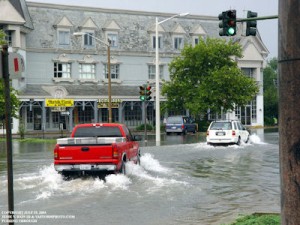My skepticism of Global Warming alarmism is well documented on this blog. But being skeptical of chicken-little, the-world-is-going-to-end hysteria is very different from being skeptical of the fact that global temperatures are rising and so is the sea level along with it. We can argue how rapidly sea levels are rising but not the fact that they are rising. Anyone who denies that fact out of a blind ideological reaction against GW alarmism is committing a grave and costly mistake.
As sea levels rise, whether due to higher global temperature or subsidence of the East Coast tectonic plate, flooding is becoming worse. As flooding becomes worse, insurance companies — who are not motivated by ideology — charge more for flood insurance. Writes Scientific American in its August issue:
Major insurance companies like Allstate, Nationwide, and State Farm have quietly stopped writing new policies in many zones near shore, says Wetlands Watch. Most of Norfolk’s waterfront lies in areas that the Federal Emergency Management Agency designates as 100-year flood zones – i.e., that have a one percent chance of flooding yearly [PDF]. Owners there can buy coverage from the National Flood Insurance Program.
Meanwhile, local governments are giving serious thought to the implications of rising sea levels. According to Scientific American: “Norfolk is spending more than $27 million this year on culverts, restored shorelines and street curbs to channel water and improve drainage. … Studies commissioned by the city have recommended more than $140 million in larger projects for just four neighborhoods, including floodgates and pumping systems. ”
Here’s my question. If flooding is demonstrably getting worse — for whatever reason — why is the federal government subsidizing property owners who want to build in flood-prone areas? This is madness! If flooding is demonstrably getting worse, why aren’t local governments in Hampton Roads “blue lining” flood-prone areas where they will no longer invest in building new infrastructure?
Surely environmentalists and free-market conservatives can unite to oppose insanely wasteful public- and private-sector investment in areas that will become only more vulnerable to flooding over time.
— JAB



